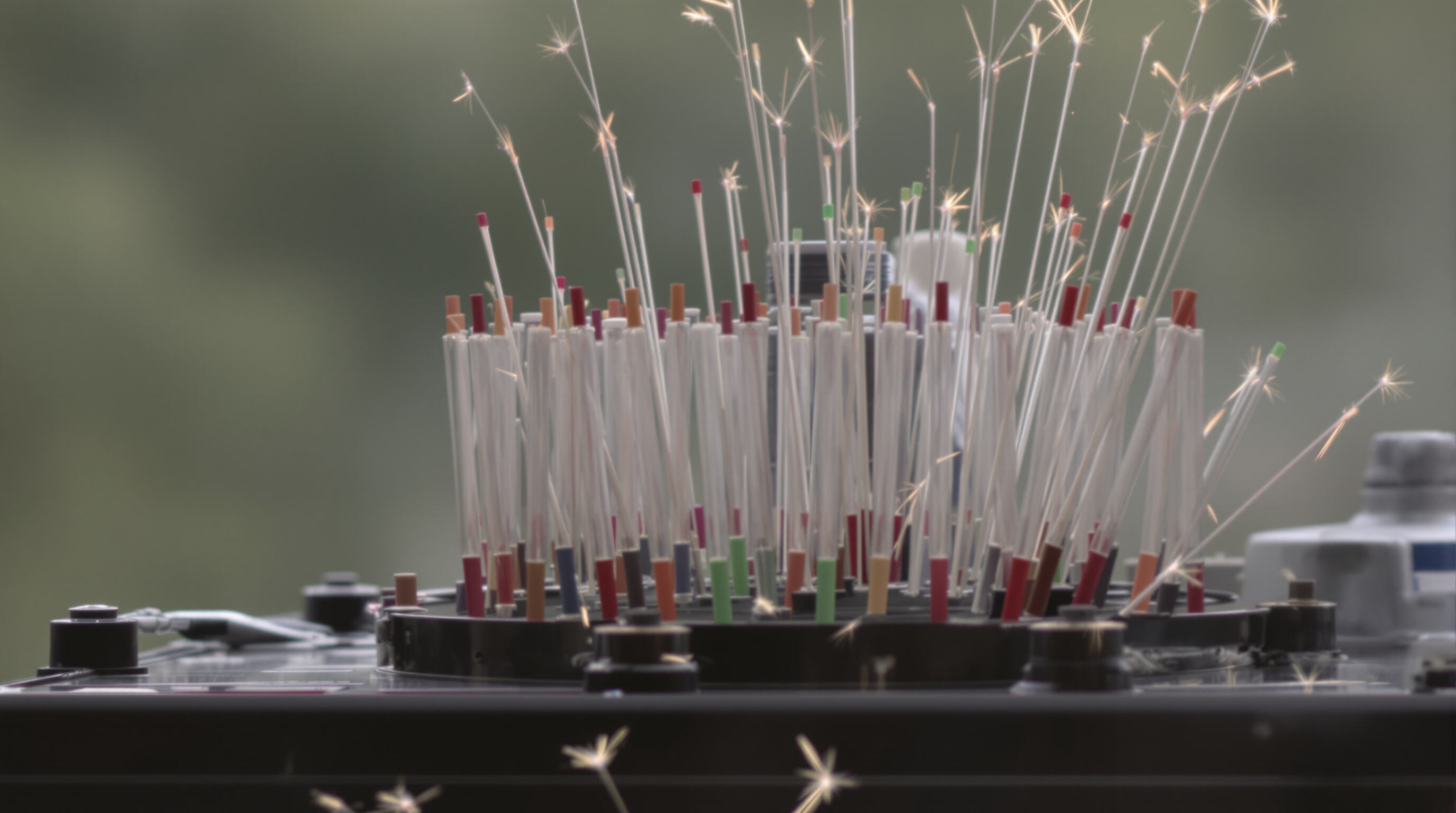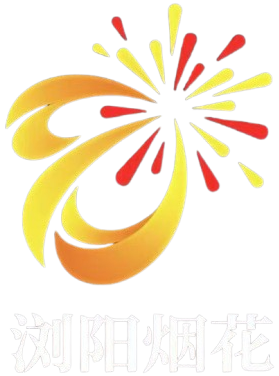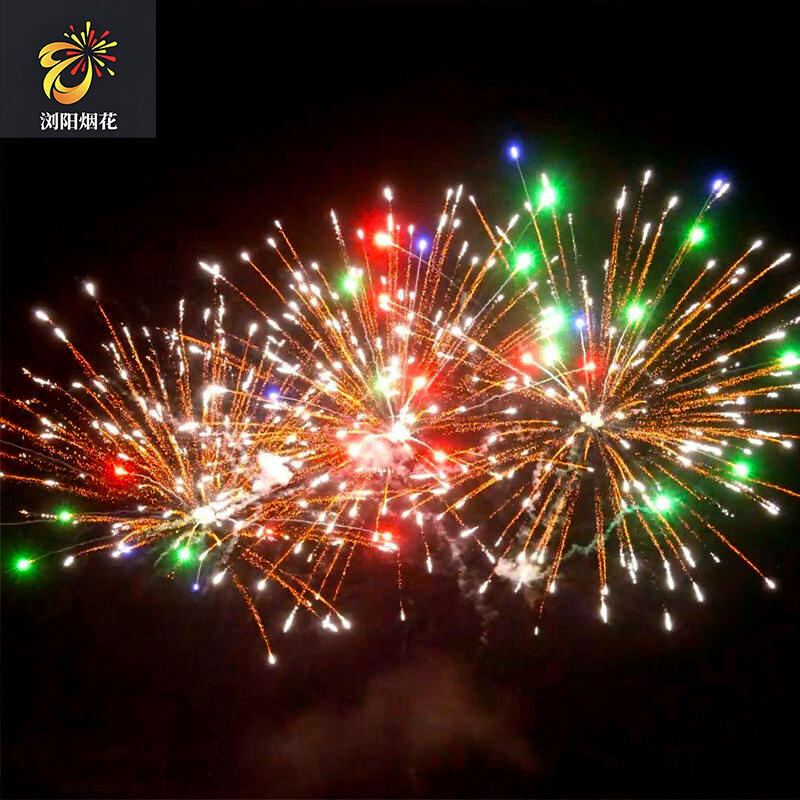Pag-unawa sa Cake Fireworks: Istraktura, Tungkulin, at Mga Multi-Shot na Epekto

Ano ang Cake fireworks at Paano Ito Naiiba sa Mga Single-Shell Fireworks?
Ang maraming tawag na cake fireworks o barrages ay karaniwang mga multi-tube device na na-load nang maaga at nagpapaputok ng sunod-sunod na pyrotechnic effect kapag isang beses lamang ito sinindi. Ang regular na fireworks ay nangangailangan ng tao para muli itong i-load tuwing sila'y sumasabog, ngunit ang cake fireworks ay mayroong lahat ng kanilang tubo na konektado upang sila ay kusang pumutok. Ang resulta ay isang buong palabas sa langit na tumatagal mula sa kalahating minuto hanggang halos dalawang minuto nang walang tigil, perpekto para sa mga party kung saan gusto ng mga tao ang patuloy na kasiyahan. Habang ang regular na fireworks ay lumilikha ng malalaking pagsabog nang mataas, hindi talaga sila sumusunod sa anumang pattern o rhythm tulad ng cake fireworks. Ang mga koordinadong palabas na ito ay maaaring mag-mix ng iba't ibang hugis tulad ng chrysanthemum blooms at willow clusters nang magkabilang-panig nang hindi naabala ang daloy nito.
Ang Agham Sa Likod ng Multi-Shot Effects Sa Cake Fireworks
Ang tumpak na pagtutuos ay nagpapagalaw sa mga serye ng maramihang paglaban ng cake fireworks sa pamamagitan ng isang panloob na sistema ng sinag. Kapag sinindihan, ang mabilis na sumusunog na sinag ay papunta sa mga kanal na nag-uugnay sa mga tubo sa isang nakapirming pagkakasunod-sunod. Ang bawat tubo ay naglalaman ng:
- Lift charge: Nagpapalitaw sa mga epekto paitaas
- Delay element: Kontrolado ang oras ng pagsabog
- Effect compartment: Tagalaman ng mga butil na nagbibigay kulay o mga bahagi na nagpapalabas ng ingay
Ang pagsunod-sunod na ito ay lumilikha ng mga naka-synchronize na disenyo, kung saan ang bawat paglaban ay nasa pagitan ng 0.5-3 segundo. Ang mga advanced na cake fireworks ay may cross-fusing upang piliin ang pagitan ng mga hanay ng tubo, na nagbibigay-daan sa mga kumplikadong visual na epekto na hindi posible sa mga single-fire device.
Mga pangunahing sangkap: Tubes , Mga sinag, at Paglulunsad ng Sekwensya
Tatlong pangunahing sangkap ang nagpapagana sa awtomatikong pagtatanghal ng cake fireworks:
| Komponente | Paggana | Karakteristik ng Materyales |
|---|---|---|
| Tubes | Bahay ng magkakahiwalay na paglaban | Cardboard o HDPE plastic; nakamuktil para sa epekto ng pamaypay |
| Mga fuse | Kontrolin ang oras ng pagsindi | Mabilisang tugma (mabilis) o visko (mabagal ang sunog) |
| Batayan | Nagtatag ng plataporma sa paglulunsad | Karton na may bigat at may patong na hindi nasusunog |
Ang paglulunsad ay nagsisimula kapag inilipat ng nangungunang sinag ang apoy sa unang tubong singaw. Ang mga susunod na putok ay nagpapagana sa pamamagitan ng pangalawang sinag na kumakalat mula sa pangunahing sanga, pinapanatili ang tumpak na timing hanggang sa matapos lahat. Ang ganitong operasyon na nakapaloob sa sarili ay nagsigurado na ang palabas ay walang tigil.
Mga Uri ng Cake Fireworks: Istruktura, Mga Disenyo ng Putok, at Tagal

Ano ang Cake Fireworks at Paano Ito Naiiba sa Tradisyonal na Fireworks?
Ang cake fireworks, na kilala rin bilang barrages, ay naiiba sa single-shell fireworks dahil binubuo ito ng serye ng pre-loaded tubes na awtomatikong paputok nang sunod-sunod gamit ang isang ignition lamang. Nagdudulot ito ng walang putol na pagpapakita ng mga pyrotechnics na tumatagal mula 30 segundo hanggang halos dalawang minuto. Habang ang karaniwang fireworks ay lumilikha ng malalakas na pagsabog, hindi sila mayroong naayos at ritmong mga disenyo ng cake fireworks, na maari nang maghalo ng iba't ibang hugis at kulay nang maayos.
Ano ang Mga Pangunahing Bahagi ng Cake Fireworks?
Ang epektibidad at awtomatikong pagpapatakbo ng cake fireworks ay nakasalalay sa tatlong pangunahing bahagi:
- Mga tubo: Karaniwang gawa sa karton o HDPE plastic, ang mga ito ay nagtatago ng mga individual shots at kadalasang nasa anggulo para sa iba't ibang visual effects.
- Mga fuse: Mga ito ang nagsusuri ng timing ng mga ignitions at maaaring quick-match para sa mabilis na pagsisimula o visco para sa mas mabagal na pagkasunog.
- PAMILYA: Isang may bigat na karton na base na nagbibigay ng katatagan at mayroong patong para maging fireproof.
Paano Pumili ng Tamang Cake Fireworks Para sa Iyong Kaganapan
Ang tamang pagpili ng cake fireworks ay makapag-elevate sa mood at makalikha ng hindi malilimutang sandali sa mga event. Para sa mas nakatuong display na nagbibigay-impak sa pamamagitan ng mataas na visual punches, ang straight-shooting fireworks na tumatagal ng 15 hanggang 30 segundo ay mainam. Kung ang layunin naman ay maka-engganyo ng mas malawak na madla, ang fan-shaped cakes, na may malawak na saklaw ng pagsabog, ay nag-aalok ng kakaibang karanasan sa lahat, anuman ang kanilang lokasyon. Para sa isang mas nakapaloob at kakaibang palabas, ang compound cakes ay nag-uugnay ng iba't ibang epekto sa isang display, lumilikha ng mas matagal na pagtatanghal na nakakapagpahiwatig sa madla sa pamamagitan ng kanilang layered spectacle.
Mga Konsiderasyon para sa Kaligtasan sa Event at Pagsunod sa Batas
Ang kaligtasan at kaalaman tungkol sa mga lokal na regulasyon ay mahalaga sa tuwing gagamit ng cake fireworks para sa mga consumer. Mahahalagang mga salik na dapat isaalang-alang ay ang pagtitiyak ng malinaw na lugar para ilunsad na hindi bababa sa 25 talampakan mula sa mga nanonood at mga materyales na madaling maagnas, pati na rin ang pagkumpirma sa mga lokal na batas hinggil sa mga limitasyon sa edad, lisensya, at mga uri ng fireworks na pinapayagan. Maraming lungsod ang nagpapatupad ng pinakamababang edad na 18 taon para sa pagbili, samantalang ang iba ay maaaring magpatupad ng mga restriksyon sa ingay o direktang bawal sa ilang uri ng fireworks. Ang hindi pagkakasunod-sunod ay maaaring magresulta ng mga parusa na lampas sa pinapayagan ng lokal na code, kaya mahalaga na laging may impormasyon.
Bagama't nagdudulot ng saya ang cake fireworks, kasama rin dito ang mga kaakibat na panganib at mga alalahanin ng publiko, lalo na ang epekto ng ingay sa mga sensitibong grupo tulad ng mga beterano, mga bata, at mga alagang hayop. Dahil sa mga alalahaning ito, inirerekumenda na ang mga pampublikong kaganapan ay dapat isaalang-alang ang pagkuha ng lisensyadong propesyonal upang hawakan ang fireworks para sa isang mas ligtas at naaangkop na palabas.
Pagsasama ng Cake Fireworks sa Iba Pang Palabas ng Fireworks para sa Mas Malaking Epekto
Upang palakasin ang kabuuang epekto ng isang palabas, ihiwalay ang cake fireworks kasama ang iba't ibang ibang uri ng fireworks, tulad ng:
- Aerial Shells: Ginagamit upang lumikha ng mataas na pagsabog sa himpapawid na nagpapahusay sa mga epektong nasa mababang antas ng cake fireworks.
- Ground Spinners: Dagdag paikot na elemento sa visual na palabas at nagpapataas ng damdamin ng paggalaw at kasiyahan.
- Fountains: Mga matagal na display sa tabi ng mesa na nag-uugnay sa cake effects para makalikha ng nakakaranas na karanasan.
Sa pamamagitan ng pagsasama ng mga elementong ito, ang mga kaganapan ay makapagbibigay ng isang mas kumpletong karanasan sa pandama na nagpapanatili ng interes sa kabuuan ng tagal nito, na lubos na nagpapahusay sa kabuuang kasiyahan ng manonood.
Pagsiguro sa Legal na Pagsunod at Kaligtasan ng Publiko
Ang pagtiyak ng kaligtasan ng publiko habang gumagamit ng cake fireworks ay nangangailangan ng pagpapanatili ng distansya na hindi bababa sa 150 talampakan mula sa mga manonood at malayo sa mga materyales na madaling maagnas. I-verify ang legal na kalagayan ng paggamit ng fireworks sa iyong lugar, dahil maaaring mag-iba-iba ang regulasyon. Ang kawalan ng kaalaman sa mga batas na ito ay maaaring magresulta sa multa na lumalampas sa lokal na code, kasama na ang posibleng pananagutan para sa pinsala sa ari-arian.
Ang mga isinasaalang-alang sa paggamit ng fireworks ng mga konsyumer kumpara sa pagdalo sa mga propesyonal na palabas ay kinabibilangan ng panganib ng apoy sa tuyong rehiyon, posibleng pinsala sa pandinig mula sa maingay na ingay, at pagiging sensitibo ng komunidad, tulad ng mga beterano o alagang hayop. Ang mga lisensiyadong propesyonal ay nagpapaseguro ng kaligtasan, wastong pamamahala ng debris, at insurance; para sa mas malalaking o mapanganib na kaganapan, ang propesyonal na palabas ay isang matalinong pagpipilian.
Madalas Itatanong na Mga Tanong (FAQ)
Ano ang mga pangunahing pagkakaiba sa pagitan ng cake fireworks at tradisyunal na fireworks?
Ang cake fireworks ay mga pre-loaded na multi-tube na aparato na nakapagpapalabas ng epekto nang automatiko sa pamamagitan ng isang beses na ignition, nagbibigay ng isang naka-coordinate at ritmikong palabas na kabaligtaran sa iisla at manual na pagpapalabas ng tradisyunal na fireworks.
Ano ang dapat kong isaalang-alang kapag pumipili ng cake fireworks para sa isang kaganapan?
Kapag pumipili ng cake fireworks, isaalang-alang ang tema ng kaganapan at ninanais na kulay, ang sukat at lawak ng kaganapan, at ang visual impact na nais makamit, depende kung ito ay isang maliit na backyard na pagtitipon o isang malaking pampublikong palabas.
Gaano kaseguro ang cake fireworks para sa consumer use?
Bagama't ang cake fireworks ay karaniwang idinisenyo para sa consumer use, mahalaga na tiyaking may sapat na safety measures, tulad ng pagpapanatili ng isang ligtas na distansya mula sa mga manonood at mga materyales na madaling maagnas. Mahalaga ang kamalayan at pagsunod sa lokal na regulasyon, lalo na tungkol sa ingay at age restrictions.
Bakit dapat kong isaalang-alang ang professional displays sa halip na consumer-grade fireworks?
Ang mga propesyonal na display ay kadalasang nag-aalok ng mas mahusay na mga hakbang sa kaligtasan, pinahusay na epekto sa paningin, at karaniwang higit na angkop para sa malalaking kaganapan o pampublikong okasyon upang matiyak ang kaligtasan ng nakararami at pagkakasunod sa batas. Maaaring hindi saklawin ng mga patakaran ng insurance sa bahay ang mga insidente na dulot ng hindi pinahihintulutang paggamit ng cake fireworks.
Talaan ng mga Nilalaman
- Pag-unawa sa Cake Fireworks: Istraktura, Tungkulin, at Mga Multi-Shot na Epekto
-
Mga Uri ng Cake Fireworks: Istruktura, Mga Disenyo ng Putok, at Tagal
- Ano ang Cake Fireworks at Paano Ito Naiiba sa Tradisyonal na Fireworks?
- Ano ang Mga Pangunahing Bahagi ng Cake Fireworks?
- Paano Pumili ng Tamang Cake Fireworks Para sa Iyong Kaganapan
- Mga Konsiderasyon para sa Kaligtasan sa Event at Pagsunod sa Batas
- Pagsasama ng Cake Fireworks sa Iba Pang Palabas ng Fireworks para sa Mas Malaking Epekto
- Pagsiguro sa Legal na Pagsunod at Kaligtasan ng Publiko
- Madalas Itatanong na Mga Tanong (FAQ)


